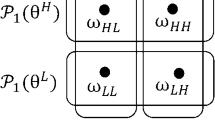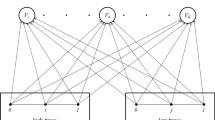Abstract
In this paper, a contest designer derives profits from aggregate effort exerted by the contestants. I develop a revelation mechanism that enables the contest designer to select a subset of contestants from a pool of candidates in a way that maximizes her profits, even though she is uninformed about the candidates’ valuations for the contest prize. I prove the existence of an incentive compatible and individually rational mechanism. I solve the designer’s problem by using a three-stage game. At Stage 0, the designer designs a mechanism. At Stage 1, candidates participate in the mechanism then a subset of candidates become contestants. Lastly, at Stage 2, information is revealed and the contestants participate in a contest. I show that the optimal size of a contest depends on contestants’ types, the cost of the prize to the designer and on the marginal cost that a contestant imposes on the designer. Contrary to models in which an entry fee s access to the contest, the designer can elicit truthful revelations by imposing revelation costs, and in turn is able to select the optimal subset of contestants.


Similar content being viewed by others
Notes
The International Union of Architect offers a guideline entitled UIA GUIDE: For International Competitions in Architecture and Town Planning Unesco Regulations, available at http://www.http://www.uia-architectes.org.
See the press release at http://www.RenewNYC.org.
To be precise, in Fullerton and McAfee (1999), all contestants value the contest prize in the same way. However, the marginal cost of effort is different for all contestants. This marginal cost of effort is the private-information element of their model. Having private information over the value of the contest prize has a one-to-one relationship with having private information over the marginal cost since \(\theta _i=1/c_i\) where \(c_i\) would be the marginal cost of effort for i.
Since the designer cannot differentiate between candidates, the mechanism is restricted to those such that \(e_i=e\), \(\forall i\in N\).
In this section, some of the derivations can also be found in Fullerton and McAfee (1999).
This model of contest satisfies the assumptions detailed in Corchón (2007) for existence and uniqueness of a Nash equilibrium.
Let \(x_i+X_{-i}=0\). i can profitably deviate by exerting strictly positive effort and win the prize with probability 1.
If i is the only individual in S who exerts strictly positive effort, i can profitably deviate by diminishing \(x_i\) by \(\varepsilon >0\) and still win the prize with probability 1.
To show that the revelation principle holds, the reader may refer to chapter 7 of Fudenberg and Tirole (1991), for instance. Note that all players, including the contest designer, have a von Neumann–Morgenstern utility, represented by (5) and by (6). Note also that at the moment of sending a message to the designer, each candidate’s utility depends only on her type \(\theta _i\) and on the “transfer” \(e(m_i)\) from the designer to the candidate, which in this case is negative. A candidate is uninformed about the other candidates’ type and can only rely on the commonly known distribution of types to compute her expected utility.
References
Amegashie JA (2000) Some results on rent-seeking contests with shortlisting. Public Choice 105(3–4):245–253
Baye MR, Kovenock D, De Vries CG (1993) Rigging the lobbying process: an application of the all-pay auction. Am Econ Rev 83:289–294
Che YK, Gale I (2003) Optimal design of research contests. Am Econ Rev 93(3):646–671
Corchón LC (2007) The theory of contests: a survey. Rev Econ Design 11(2):69–100
Franke J, Kanzow C, Leininger W, Schwartz A (2013) Effort maximization in asymmetric contest games with heterogeneous contestants. Econ Theor 52(2):589–630
Fu Q, Lu J (2010) Contest design and optimal endogenous entry. Econ Inq 48(1):80–88
Fu Q, Lu J (2012) The optimal multi-stage contest. Econ Theor 51(2):351–382
Fu Q, Jiao Q, Lu J (2015) Contests with endogenous entry. Int J Game Theory 44(2):387–424
Fudenberg D, Tirole J (1991) Game theory. MIT Press, Cambridge
Fullerton RL, McAfee RP (1999) Auctionin entry into tournaments. J Polit Econ 107(3):573–605
Giebe T (2014) Innovation contests with entry auction. J Math Econ 55:165–176
Gradstein M, Konrad KA (2001) Orchestrating rent seeking contests. In: Lockard AA, Tullock G (eds) Efficient rent-seeking. Springer, Berlin, pp 361–369
Kaplan TR, Sela A (2010) Effective contests. Econ Lett 106(1):38–41
Lai EK, Matros A (2007) Sequential contests with ability revelation. Tech. rep., Mimeo
Long NV (2013) The theory of contests: a unified model and review of the literature. Eur J Polit Econ 32:161–181
Moldovanu B, Sela A (2006) Contest architecture. J Econ Theory 126(1):70–96
Nitzan S (1994) Modelling rent-seeking contests. Eur J Polit Econ 10(1):41–60
Polishchuk L, Tonis A (2013) Endogenous contest success functions: a mechanism design approach. Econ Theor 52(1):271–297
Taylor CR (1995) Digging for golden carrots: an analysis of research tournaments. Am Econ Rev 85(4):872–890
Zhang J, Wang R (2009) The role of information revelation in elimination contests. Econ J 119(536):613–641
Acknowledgements
This paper is a revised and updated version of the second chapter of my Ph.D. thesis at McGill University entitled “Three Essays in Contest Theory”. I wish to thank my supervisor Licun Xue for his guidance. I also wish to thank Ngo Van Long, Rohan Dutta, Takashi Kunimoto, Marco Serena, Alex Vasquez-Sedano, Luis Corchon, Dorothea Herreiner and the participants to various conferences and seminars at which this paper was presented. I am also grateful to two anonymous referees and to the associate editor who helped make this paper better.
Author information
Authors and Affiliations
Corresponding author
Rights and permissions
About this article
Cite this article
Mercier, JF. Selecting contestants for a rent-seeking contest. Int J Game Theory 47, 927–947 (2018). https://doi.org/10.1007/s00182-017-0610-x
Accepted:
Published:
Issue Date:
DOI: https://doi.org/10.1007/s00182-017-0610-x




